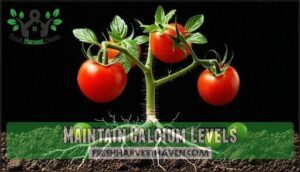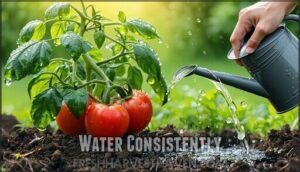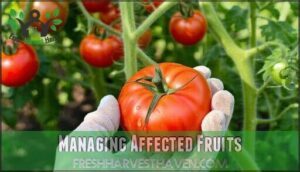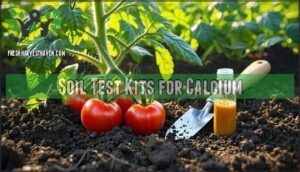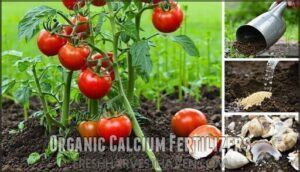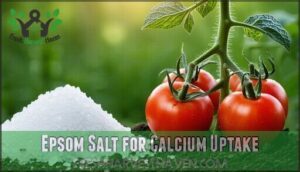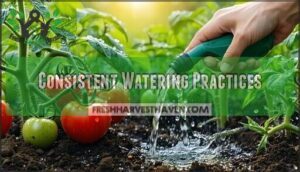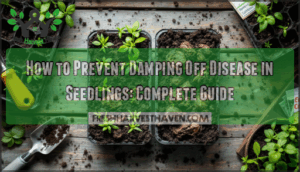This site is supported by our readers. We may earn a commission, at no cost to you, if you purchase through links.
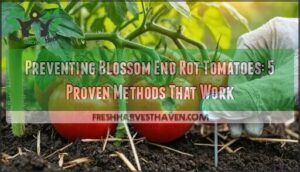 Preventing blossom end rot tomatoes starts with consistent watering—the root cause isn’t actually calcium shortage in your soil, but your plant’s inability to transport existing calcium when moisture levels swing like a pendulum.
Preventing blossom end rot tomatoes starts with consistent watering—the root cause isn’t actually calcium shortage in your soil, but your plant’s inability to transport existing calcium when moisture levels swing like a pendulum.
You’ll need to maintain steady soil moisture through deep, regular watering and mulching around plants.
Check your soil’s pH level too; tomatoes absorb calcium best between 6.0-6.8.
Avoid nitrogen-heavy fertilizers that interfere with calcium uptake, and consider adding calcium sulfate if soil tests reveal deficiencies.
The dark, sunken spots that mark this frustrating condition are completely preventable when you master these fundamentals and understand the surprising connection between root health and fruit development.
Table Of Contents
- Key Takeaways
- Causes of Blossom End Rot
- Preventing Blossom End Rot
- Managing Affected Fruits
- Effective Prevention Strategies
- Tomato Care Best Practices
- Frequently Asked Questions (FAQs)
- What nutrient is necessary to prevent blossom end rot?
- Is blossom end rot caused by overwatering?
- What is the best source of calcium for tomato plants?
- What can I spray on tomatoes for blossom end rot?
- Will Miracle-Gro help blossom end rot?
- Can overwatering cause blossom end rot on tomatoes?
- Can companion plants prevent blossom end rot?
- Can blossom end rot spread between plants?
- Is blossom end rot hereditary in heirloom varieties?
- How quickly can calcium amendments show results?
- Conclusion
Key Takeaways
- You’ll prevent blossom end rot by maintaining consistent soil moisture – water deeply twice weekly rather than daily light sprinkles to ensure steady calcium transport to developing fruits.
- Test your soil pH and keep it between 6.0-6.8 – this range maximizes calcium absorption, while pH outside this zone locks up nutrients regardless of soil amendments.
- Apply 2-3 inches of organic mulch around plants – this maintains steady soil temperature and moisture levels while preventing the stress that triggers calcium uptake problems.
- Avoid nitrogen-heavy fertilizers during fruit development – excessive nitrogen triggers rapid leaf growth that steals calcium from developing tomatoes, making blossom end rot more likely.
Causes of Blossom End Rot
You’ll likely encounter blossom end rot if your tomato plants can’t access enough calcium or if watering becomes inconsistent.
The dark, sunken spots on fruit bottoms result from calcium deficiency caused by poor soil conditions, irregular moisture, or nutrient imbalances that block calcium uptake.
Calcium Deficiency Causes
Calcium deficiency is the primary culprit behind preventing blossom end rot in your tomato plants.
Your tomatoes need steady calcium levels throughout fruit development, but poor nutrient uptake often sabotages this process.
Even calcium-rich soil won’t help if your plant’s root health is compromised or fertilizer types block absorption.
Regular soil testing reveals whether you’re fighting calcium deficiency or uptake issues – knowledge that’s essential for preventing tomato rot before it starts affecting your harvest.
Understanding the role of calcium for tomatoes is essential for maintaining healthy plants and maximizing fruit production.
Environmental Factors Contribution
Spotting environmental factors early helps you stay ahead of blossom end rot. Think of your garden as a balancing act—too much or too little can tip the scales.
Watch out for:
- Soil Temperature swings
- Poor Water Quality
- Air Pollution impacts
- Climate Change effects
- Soil Erosion lowering soil quality
These can disrupt soil moisture, irrigation management, and trigger water stress.
Low Calcium Levels
Your tomato plants can’t absorb calcium properly when soil levels are inadequate, even if you’ve added calcium supplements.
Soil testing reveals whether your garden has sufficient available calcium for healthy tomato plant problems prevention.
Poor soil quality matters because bound calcium remains unusable to roots.
Nutrient balance affects calcium uptake substantially, making fertilizer options critical for preventing blossom end rot and achieving a blossom end rot cure through preventing rot strategies.
Improper Soil Moisture
Inconsistent watering creates a rollercoaster effect that disrupts calcium uptake in your tomato plants.
When soil moisture levels swing from bone-dry to waterlogged, your plants can’t absorb nutrients properly, preventing blossom end rot becomes nearly impossible.
Consistent moisture is your tomato plants’ lifeline—erratic watering blocks calcium uptake completely.
Proper irrigation management means maintaining steady water balance through consistent soil monitoring.
Think of it like keeping your plants on a reliable schedule—they thrive with predictable moisture levels that support healthy soil quality matters for long-term tomato plant problems prevention, which is crucial for overall plant health.
Excessive Nitrogen Fertilizer
When you pour on too much nitrogen fertilizer, you’re actually sabotaging your tomato nutrition.
Excessive nitrogen fertilizer triggers rapid leaf growth that steals calcium from developing fruits.
This nitrogen overuse creates nutrient imbalance, preventing blossom end rot protection your plants desperately need.
Fertilizer management means avoiding plant burn and soil toxicity that disrupts proper soil composition and calcium transport.
Proper calcium uptake methods are essential to prevent this issue and guarantee healthy tomato growth.
Soil PH Imbalance
Wrong soil pH creates a chemical lockout that blocks your tomato plants from accessing calcium, even when plenty exists in the ground.
pH imbalance locks away calcium your plants desperately need, even in calcium-rich soil.
This invisible barrier triggers devastating blossom end rot despite your best efforts.
Here are five pH problems that sabotage calcium uptake:
- Acidic soils below 6.3 – turns calcium into unusable compounds
- Alkaline conditions above 6.8 – binds calcium beyond root reach
- Fluctuating pH levels – creates unpredictable nutrient availability
- Untested soil conditions – leaves you guessing about hidden problems
- Poor soil amendments – worsen existing pH imbalances
Regular soil testing reveals these hidden culprits before they destroy your harvest.
Preventing Blossom End Rot
You can successfully prevent blossom end rot by addressing calcium availability and maintaining consistent soil moisture.
These proven methods target the root causes and create ideal growing conditions for healthy tomato development, which helps in preventing blossom end rot by ensuring consistent soil moisture.
Maintain Calcium Levels
Your soil’s calcium levels directly impact preventing blossom end rot.
Conduct soil testing to determine current calcium status and pH levels.
Apply calcium supplements like gypsum or calcium nitrate during fruit set for maximum calcium uptake.
These soil amendments boost nutrient management without altering pH.
Proper fertilizer application guarantees your plants get adequate calcium for strong cell walls and healthy fruit development, which is crucial for healthy fruit.
Water Consistently
Regular watering is your secret weapon for preventing blossom end rot.
Maintain steady soil moisture by watering deeply twice weekly rather than light daily sprinkles.
Check soil moisture two inches down—it should feel like a wrung-out sponge.
Consistent hydration helps your tomato plants absorb calcium effectively, making proper water management essential for healthy tomato plant health and preventing this frustrating condition.
Apply Mulch
Why let weeds steal your tomatoes’ nutrients? Mulching creates a protective barrier that locks in moisture while blocking unwanted competition.
This simple step keeps soil temperature stable, preventing the stress that triggers blossom end rot.
Key mulch benefits for preventing blossom end rot:
- Moisture retention – Maintains consistent soil hydration
- Weed control – Eliminates nutrient competition
- Soil temperature regulation – Reduces plant stress
Apply 2-3 inches of organic matter around plants for ideal tomato care and improved soil health.
Maintaining healthy soil also helps in disease prevention strategies.
Maintain PH Levels
Testing frequency should happen twice yearly to maintain ideal soil conditions.
Soil acidity between 6.3-6.8 maximizes nutrient availability, preventing blossom end rot in tomatoes.
PH meters provide accurate readings for precise lime application when needed.
Regular soil amendments adjust pH balance, creating ideal growing conditions for healthy fruit development, which is crucial for healthy fruit.
Managing Affected Fruits
When you spot blossom end rot on your tomatoes, you’ll need to act quickly to save the rest of your harvest.
You can’t reverse the damage on affected fruits, but proper management prevents the problem from spreading to healthy tomatoes still developing on the plant.
Trim Damaged Portions
When you spot affected tomatoes, quick action prevents further spread.
Pruning Techniques for removing damaged tissue help plants focus energy on healthy fruit development.
- Sterilize pruning shears with rubbing alcohol between cuts
- Cut affected fruits at least one inch below visible damage
- Dispose of trimmed portions away from garden area
- Apply wound sealing compound to larger cut surfaces
- Clean tools thoroughly after completing Plant Recovery work
Tool Sterilization stops cross-contamination between plants.
Identifying Damage early makes treatment more effective for preventing blossom end rot progression in your tomatoes.
This approach ensures that your efforts are focused on healthy fruit development.
Monitor Plants for Early Signs
Daily checks help catch problems before they spread.
Look for small, dark spots on fruit bottoms and yellowing leaves around affected areas. Watch for stunted growth patterns and wilting blossoms that signal calcium uptake issues.
Early symptom identification through regular fruit inspection frequency gives you time to adjust your tomato soil requirements and implement preventing measures before widespread damage occurs, allowing for early symptom identification and prompt action.
Remove Severely Affected Fruits
Once you’ve spotted early warning signs, promptly remove severely affected fruits to protect your harvest. Fruit Removal Timing matters—don’t wait for complete deterioration.
Energy Redirection helps plants focus resources on healthy tomatoes, while Disease Prevention stops rot from spreading to nearby fruit.
- Cut affected fruits at the stem using clean pruning shears
- Dispose of removed fruits away from your garden area
- Check remaining tomatoes for Plant Health Impact signs
Continue Preventive Measures
Preventing doesn’t end once you remove damaged fruits—it’s just the beginning of your long-term solutions strategy.
Consistent prevention through regular monitoring creates a holistic approach that adapts as conditions change.
Keep applying calcium amendments, maintaining proper watering schedules, and checking soil pH levels.
These adaptive strategies guarantee your tomato blossom care routine stays effective throughout the growing season.
Regularly sterilize garden tools to prevent the spread of pathogens.
Effective Prevention Strategies
You’ll need a combination of proactive soil management and consistent care practices to stop blossom end rot before it starts.
These four proven strategies address the root causes while giving you practical tools to monitor and maintain healthy calcium levels throughout the growing season.
Soil Test Kits for Calcium
Accurate soil testing gives you the power to catch calcium deficiencies before they destroy your tomato harvest. Smart gardeners test twice yearly for reliable fruit rot prevention and ideal soil nutrients.
You can use convenient testing options to assess your soil.
- Kit Accuracy: Choose thorough test kits that measure calcium alongside pH for complete nutrient deficiency detection
- Sample Collection: Mix soil from 5-7 spots at 4-6 inch depth, creating one representative sample for testing
- Testing Frequency: Test spring and fall to track calcium changes from weather and fertilization cycles
Organic Calcium Fertilizers
Several organic calcium sources can turn your tomato troubles around when blossom end rot strikes.
Bone meal provides slow-release calcium and phosphorus for strong fruit development. Crushed eggshells offer sustainable calcium that breaks down gradually.
Compost tea delivers nutrients while improving organic matter content. Greensand and rock phosphate serve as natural soil amendments for plants, supporting long-term plant nutrition and effective fruit rot prevention.
You can also use crushed oyster shells to balance pH and support strong fruit development with natural soil amendments and sustainable calcium.
Epsom Salt for Calcium Uptake
Despite the Epsom salt myth suggesting it prevents blossom end rot, magnesium vs calcium confusion persists among gardeners.
Epsom salt provides magnesium, not calcium—the actual nutrient your tomatoes need.
While foliar Epsom spray can address magnesium deficiency symptoms, it won’t fix calcium-related blossom end rot.
Many gardeners find Epsom salts beneficial for overall plant health.
Save your energy for proper soil amendments that actually boost calcium availability instead.
Consistent Watering Practices
Water your tomatoes deeply but less often to promote strong root development.
Deep soaking twice weekly beats daily shallow watering, which encourages surface roots vulnerable to drought stress.
Check soil moisture two inches down—it should feel like a wrung-out sponge.
Install drip irrigation or soaker hoses for consistent delivery.
Proper drainage solutions prevent waterlogged roots while mulch benefits include moisture retention.
Tomato Care Best Practices
Beyond addressing root causes, proper tomato care practices create the foundation for consistently healthy fruit production.
You’ll find that maintaining ideal growing conditions prevents blossom end rot before it starts, saving you from the frustration of losing otherwise perfect tomatoes, which is a key aspect of healthy fruit production.
Optimal Soil PH Range
You’ll prevent blossom end rot by maintaining soil pH between 6.2-6.8, where calcium absorption peaks.
Soil acidity outside this range locks up nutrients, regardless of amendments.
Regular pH testing reveals when amending soil becomes necessary, and proper management involves using lime for acidic conditions or sulfur for alkaline soils.
Proper soil management guarantees the best nutrient availability and healthy soil conditions throughout the growing season.
Balanced Fertilization Techniques
Timing your fertilizer applications can make or break your tomato harvest.
Early season requires balanced 10-10-10 nutrient ratios every 2-3 weeks, then switch to phosphorus-rich 5-10-10 formulas mid-season.
Soil testing reveals which fertilizer types work best – organic amendments like compost for healthy soils, synthetic options for deficient ground.
To optimize plant growth, consider granular fertilizer application during initial soil preparation.
This balanced approach helps prevent blossom end rot and ensures a healthy harvest by using the right fertilizer at the right time, making soil testing and fertilizer applications crucial steps.
Crop Rotation Methods
Beyond proper fertilization, smart crop rotation protects your tomato plants from the soil-borne issues that contribute to blossom end rot. You’ll break disease cycles and restore soil nutrients by rotating plant families annually.
Effective tomato gardening 101 rotation strategies:
- Rotation Benefits: Move tomatoes to different garden sections each year to prevent blossom end rot
- Soil Health: Follow tomatoes with legumes like beans to restore nitrogen balance
- Pest Control: Break pest life cycles that weaken plants and affect calcium uptake
- Nutrient Cycling: Alternate heavy feeders with soil-building crops for healthy tomato plants
- Planning Rotations: Use a three-year cycle with tomato care tips tracking system for best results
To streamline this process, consider using a dedicated rotation tool.
Frequently Asked Questions (FAQs)
What nutrient is necessary to prevent blossom end rot?
Picture those dark, sunken spots on your tomato’s bottom – that’s blossom end rot calling for calcium.
You’ll need adequate calcium in your soil, ideally with pH between 3-8, to keep your plants healthy and productive.
Is blossom end rot caused by overwatering?
Overwatering doesn’t directly cause blossom end rot, but it can worsen the problem.
Inconsistent watering prevents your tomatoes from absorbing calcium properly, leading to those telltale black spots on fruit bottoms.
What is the best source of calcium for tomato plants?
Like adding rebar to concrete, calcium sulfate (gypsum) strengthens your tomato plants from within.
You’ll get best results mixing 1/4 cup gypsum into each planting hole—it’s readily available and won’t alter your soil’s pH like lime can.
What can I spray on tomatoes for blossom end rot?
Spray calcium chloride solution directly on affected fruits and leaves. You can’t cure existing blossom end rot, but foliar calcium applications help new fruit development when soil uptake is compromised.
Will Miracle-Gro help blossom end rot?
Miracle-Gro won’t fix blossom end rot directly since it’s caused by calcium deficiency, not nitrogen shortage. You need calcium amendments like gypsum or garden lime instead.
Can overwatering cause blossom end rot on tomatoes?
Yes, you can definitely trigger blossom end rot by overwatering your tomatoes.
Too much water blocks calcium absorption, creating the same nutrient deficiency that causes those telltale black, sunken spots on fruit bottoms.
Can companion plants prevent blossom end rot?
Companion plants can’t directly prevent blossom end rot since it’s caused by calcium deficiency and inconsistent watering, not pest issues.
However, deep-rooted companions like marigolds improve soil structure, helping your tomatoes absorb calcium more effectively.
Can blossom end rot spread between plants?
No, blossom end rot doesn’t spread between plants since it’s a physiological disorder caused by calcium deficiency, not an infectious disease. You can’t "catch" it from neighboring tomatoes.
Is blossom end rot hereditary in heirloom varieties?
Heirloom varieties aren’t genetically predisposed to blossom end rot, but they can inherit traits affecting calcium uptake.
You’ll find some cultivars naturally struggle more with this physiological disorder due to their growth habits and water needs.
How quickly can calcium amendments show results?
Unfortunately, soil amendments are rarely as cooperative as a quick fix might suggest.
Results typically take 2-4 weeks to become noticeable as calcium slowly integrates into root uptake systems and transport processes.
Remember, proper watering consistency matters more than amendment timing for preventing calcium-related plant issues, and understanding this concept is key to successful calcium management.
Conclusion
Recent studies show that 80% of home gardeners experience blossom end rot in their first tomato-growing season.
Successfully preventing blossom end rot tomatoes requires mastering moisture management above all else.
You’ve learned that calcium transport, not calcium shortage, drives this condition.
Consistent watering schedules, proper mulching, and maintaining soil pH between 6.0-6.8 will eliminate those frustrating black spots.
Your plants need steady care, not dramatic interventions, to produce perfect tomatoes.
- https://www.arbico-organics.com/category/controlling-blossom-end-rot
- https://platthillnursery.com/blossom-end-rot-identification-treatment-and-prevention/
- https://growtomatoeseasily.com/how-to-avoid-blossom-end-rot-on-your-homegrown-tomatoes/
- https://docs.google.com/forms/d/1GAQr3Kn1cURCVHUA82hAga1Wv8DCH0IuqDLRUrOpN7M/viewform?ts=63f4f653&entry.1515682415=https://www.merriam-webster.com/thesaurus%2Fpreventing
- https://premium.britannica.com/mw-unabridged/?utm_source=mw&utm_medium=inline-def&utm_campaign=evergreen

